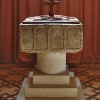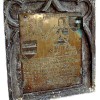When Harold fell at Hastings in 1066 it was bad news for the Saxons throughout England. Over the following few years they saw their possessions sold, they were turned out of their manors and turfed off their land, which was then granted to the conquering Normans. The Saxon, Alward, owned the manor of Stures and he faired no better than the rest. The manor was situated at the foot of Hod Hill, where the Ewerne stream meets the river Stour. Twenty years on from the famous battle at Hastings it was granted to Humphrey the Chamberlain when, according to the Domesday Book, the combined population of Stures with the hamlets of Ashe and Lazerton was 28.
By 1135 the records show that Hilias de Oresculz held the manor and it was his son, Richard, who gave land and advowson in Stures to the Priory church of Christchurch in Twyneham. Richard’s daughter Matilda married William Fitzjohn and they had two sons and a daughter. One of their sons was named Payne and this son had a son named William Fitzpayne, who had three sons: Richard de Stures Payn, who became the first rector of the parish in 1291, and Nicholas who also became a priest, leaving the third son, Bartholomew, to inherit. By 1316 Bartholomew had been knighted and confirmed by the sheriff as Lord of Sture Payne and Edmondsham.
Records reveal that in 1311 John Payne sued Roger Spurnhare and William Nots 100s for trespass and damage. The particulars of the case were recorded in some detail but on the day appointed for the hearing the clerk entered the words “They did not come.” It appears this happened three times and when the case came up for the forth time a despairing clerk wrote “Similar entry as above.”
The following year there was a dispute between the Abbess of Tarrant Crawford and Bartholomew Payne over the possession of some meadow land and grazing rights after the hay had been harvested. The court decided in favour of Bartholomew Payne and said the Abbess takes nothing, but is “In mercy for a false claim.” The Knight was back at court again that year when he sued several people for trespass and damages, but the record reveals a disregard for the court was becoming usual as the words “they did not come” again appears in the record. During the reign of Richard II (1377-1399), Stour Payne was granted to Edward Payne.
The last Payne died without an heir and in Edward IV’s reign (1461-1483) the lands were transferred to the Hussey family of Shapwick. In1645, during the Civil War, a farm belonging to Joseph Hussey, ensign to Col. Phillips, a Royalist, was sequestrated by Parliament; Joseph was buried at Stour Payne in 1685. Another Hussey, Robert, also chose a military career and he was an officer at the battle of Quebec in 1759 and fell alongside his commanding officer, General Wolfe. Some of the troops who took part in the battle of Quebec had been trained near to Stourpaine. (See our story about Iwerne Courtney.) Robert had two sons, both named Hubert. The youngest son was buried here in 1742; a second son was baptised here in 1744 or 1745 and when still a young man went off to London.
In the 19th century the inhabitants were in the main agricultural workers earning low wages and living in ill-kept cottages housing large families who would typically occupy one small room. Children were deprived of their education, kept away from school to work on allotments and knit clothes for sale. A lot of girls as young as ten and eleven were employed making gloves, all to bring in a little more money. It was a miserable existence, as the Vicar of Stourpaine reported to the Poor Law Commissioners in 1867. It was noted that the behaviour of some women was a problem: “There are more bastard children (in Stourpaine) than in any other (Dorset) village,” a report concluded.
In the Domesday Book a gift of land to the church is mentioned but there is nothing else to suggest there was a church here in Saxon times. In 1190, on the site of the present church, building work started and was completed in 1300. In the 15th century the tower was demolished and the present tower was built.
In 1858 the church had deteriorated and T.H. Wyatt undertook the construction of a new chancel and nave. He saved a few features from the original church including the 15th century west tower and a kneeling effigy of John Straight in black gown with gathered sleeves and tall collar; he was vicar here from 1650-1659. The original font was lost. The pulpit was carved by the vicar, Charles Sweet and four parishioners, between 1911 and 1914.
Lazerton was a separate parish, its church dedicated to St. Andrew. In the late 12th century a charter states it was so poor that it was released “from all payments except synodals.” The parish of Lazerton was not taxed in 1428 when it had fewer than ten inhabitants. In 1431 Lazerton was joined with Stourpaine because “the church at Lazerton had so small profits that it had been and was then destitute of a chaplain.” Lazerton was uninhabited when the 1662 Hearth Tax returns were made. Today there is nothing to show of Lazerton; what did remain was destroyed in 1962.
Today the village is divided by the main Blandford to Shaftesbury road, on the one side of which is an estate of modern housing and on the other side cob and thatched cottages and the church. With the views to the vale of Blackmore and its proximity to Hod Hill with its ancient British fort it is not surprising that many ramblers and tourists come this way.



